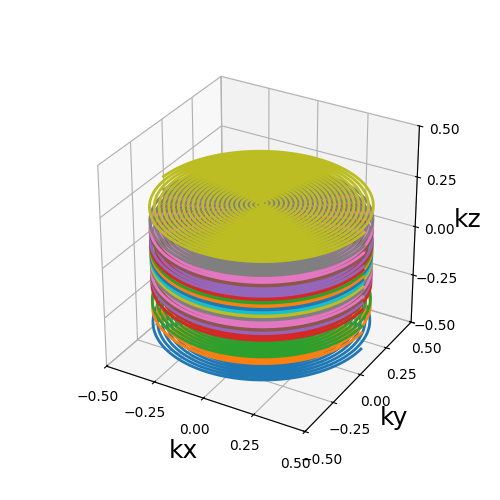Note
Go to the end to download the full example code.
Compare Fourier Model and T2* Model for Stack of Spirals trajectory#
This examples walks through the elementary components of SNAKE.
Here we proceed step by step and use the Python interface. A more integrated
alternative is to use the CLI snake-main
# Imports
from snake.core.simulation import SimConfig, default_hardware, GreConfig
from snake.core.phantom import Phantom
from snake.core.smaps import get_smaps
from snake.core.sampling import StackOfSpiralSampler
from mrinufft import get_operator
# For faster computation, try to use the GPU
NUFFT_BACKEND = "stacked-cufinufft"
COMPUTE_BACKEND = "cupy"
try:
import cupy as cp
if not cp.cupy.cuda.runtime.getDeviceCount():
raise ValueError("No CUDA Device found")
get_operator("stacked-cufinufft")
except Exception:
try:
get_operator("stacked-finufft")
except ValueError as e:
raise ValueError("No NUFFT backend available") from e
NUFFT_BACKEND = "stacked-finufft"
COMPUTE_BACKEND = "numpy"
print(
f"Using NUFFT backend: {NUFFT_BACKEND}", f"Using Compute backend: {COMPUTE_BACKEND}"
)
Using NUFFT backend: stacked-finufft Using Compute backend: numpy
sim_conf = SimConfig(
max_sim_time=3,
seq=GreConfig(TR=50, TE=22, FA=12),
hardware=default_hardware,
)
sim_conf.hardware.n_coils = 1 # Update to get multi coil results.
sim_conf.hardware.field_strength = 7
sim_conf.fov.res_mm = (3, 3, 3)
phantom = Phantom.from_brainweb(sub_id=4, sim_conf=sim_conf, tissue_file="tissue_7T")
Setting up Acquisition Pattern and Initializing Result file.#
# The next piece of simulation is the acquisition trajectory.
# Here nothing fancy, we are using a stack of spiral, that samples a 3D
# k-space, with an acceleration factor AF=4 on the z-axis.
sampler = StackOfSpiralSampler(
accelz=4,
acsz=0.1,
orderz="top-down",
nb_revolutions=12,
obs_time_ms=30,
constant=True,
)
The acquisition trajectory looks like this
traj = sampler.get_next_frame(sim_conf)
from mrinufft.trajectories.display import display_3D_trajectory
display_3D_trajectory(traj)

<Axes3D: xlabel='kx', ylabel='ky', zlabel='kz'>
traj.shape
(19, 30000, 3)
Adding noise in Image#
from snake.core.handlers.noise import NoiseHandler
noise_handler = NoiseHandler(variance=0.01)
Acquisition with Cartesian Engine#
The generated file example_EPI.mrd does not contains any k-space data for
now, only the sampling trajectory. let’s put some in. In order to do so, we
need to setup the acquisition engine that models the MR physics, and get
sampled at the specified k-space trajectory.
SNAKE comes with two models for the MR Physics:
model=”simple” :: Each k-space shot acquires a constant signal, which is the image contrast at TE.
model=”T2s” :: Each k-space shot is degraded by the T2* decay induced by each tissue.
# Here we will use the "simple" model, which is faster.
#
# SNAKE's Engine are capable of simulating the data in parallel, by distributing
# the shots to be acquired to a set of processes. To do so , we need to specify
# the number of jobs that will run in parallel, as well as the size of a job.
# Setting the job size and the number of jobs can have a great impact on total
# runtime and memory consumption.
#
# Here, we have a single frame to acquire with 60 frames (one EPI per slice), so
# a single worker will do.
from snake.core.engine import NufftAcquisitionEngine
engine = NufftAcquisitionEngine(model="simple", snr=30000)
engine(
"example_spiral.mrd",
sampler,
phantom,
sim_conf,
handlers=[noise_handler],
worker_chunk_size=60,
n_workers=1,
nufft_backend=NUFFT_BACKEND,
)
engine_t2s = NufftAcquisitionEngine(model="T2s", snr=30000)
engine_t2s(
"example_spiral_t2s.mrd",
sampler,
phantom,
sim_conf,
handlers=[noise_handler],
worker_chunk_size=60,
n_workers=1,
nufft_backend=NUFFT_BACKEND,
)
Existing example_spiral.mrd it will be overwritten
[Errno 2] No such file or directory: 'example_spiral.mrd'
Volumic TR does not align with max simulation time, last incomplete frame will be discarded.
Updating the max_sim_time to match.
0%| | 0/57 [00:00<?, ?it/s]
81%|████████ | 46/57 [00:00<00:00, 458.10it/s]
100%|██████████| 57/57 [00:00<00:00, 462.86it/s]
/volatile/github-ci-mind-inria/.local/lib/python3.10/site-packages/xsdata/formats/dataclass/parsers/utils.py:126: ConverterWarning: Failed to convert value for `waveformInformationType.waveformType`
`56449` is not a valid `waveformInformationTypeWaveformType`
warnings.warn(message, ConverterWarning)
No coil_cov found in the dataset.
0%| | 0/57 [00:00<?, ?it/s]/volatile/github-ci-mind-inria/gpu_mind_runner/_work/_tool/Python/3.10.16/x64/lib/python3.10/site-packages/mrinufft/_utils.py:94: UserWarning: Samples will be rescaled to [-pi, pi), assuming they were in [-0.5, 0.5)
warnings.warn(
/volatile/github-ci-mind-inria/gpu_mind_runner/_work/_tool/Python/3.10.16/x64/lib/python3.10/site-packages/mrinufft/_utils.py:94: UserWarning: Samples will be rescaled to [-pi, pi), assuming they were in [-0.5, 0.5)
warnings.warn(
60it [00:02, 20.42it/s]
60it [00:03, 16.51it/s]
Existing example_spiral_t2s.mrd it will be overwritten
[Errno 2] No such file or directory: 'example_spiral_t2s.mrd'
0%| | 0/57 [00:00<?, ?it/s]
79%|███████▉ | 45/57 [00:00<00:00, 449.66it/s]
100%|██████████| 57/57 [00:00<00:00, 452.36it/s]
/volatile/github-ci-mind-inria/.local/lib/python3.10/site-packages/xsdata/formats/dataclass/parsers/utils.py:126: ConverterWarning: Failed to convert value for `waveformInformationType.waveformType`
`56449` is not a valid `waveformInformationTypeWaveformType`
warnings.warn(message, ConverterWarning)
No coil_cov found in the dataset.
0%| | 0/57 [00:00<?, ?it/s]/volatile/github-ci-mind-inria/gpu_mind_runner/_work/_tool/Python/3.10.16/x64/lib/python3.10/site-packages/mrinufft/_utils.py:94: UserWarning: Samples will be rescaled to [-pi, pi), assuming they were in [-0.5, 0.5)
warnings.warn(
60it [00:07, 7.77it/s]
60it [00:08, 7.20it/s]
Simple reconstruction#
Getting k-space data is nice, but
SNAKE also provides rudimentary reconstruction tools to get images (and check
that we didn’t mess up the acquisition process).
This is available in the companion package snake.toolkit.
Loading the .mrd file to retrieve all information can be done using the
ismrmd python package, but SNAKE provides convenient dataloaders, which are
more efficient, and take cares of managing underlying files access. As we are
showcasing the API, we will do things manually here, and use only core SNAKE.
from snake.mrd_utils import NonCartesianFrameDataLoader
from snake.toolkit.reconstructors import (
SequentialReconstructor,
ZeroFilledReconstructor,
)
zer_rec = ZeroFilledReconstructor(
nufft_backend=NUFFT_BACKEND, density_compensation=None
)
seq_rec = SequentialReconstructor(
nufft_backend=NUFFT_BACKEND,
density_compensation=None,
max_iter_per_frame=30,
threshold=2e-6,
optimizer="fista",
compute_backend=COMPUTE_BACKEND,
)
with NonCartesianFrameDataLoader("example_spiral.mrd") as data_loader:
adjoint_spiral = abs(zer_rec.reconstruct(data_loader)[0])
cs_spiral = abs(seq_rec.reconstruct(data_loader)[0])
with NonCartesianFrameDataLoader("example_spiral_t2s.mrd") as data_loader:
adjoint_spiral_T2s = abs(zer_rec.reconstruct(data_loader, sim_conf)[0])
cs_spiral_T2s = abs(seq_rec.reconstruct(data_loader)[0])
Traceback (most recent call last):
File "/volatile/github-ci-mind-inria/gpu_mind_runner/_work/snake-fmri/snake-fmri/examples/anatomical/example_gpu_anat_spirals.py", line 184, in <module>
cs_spiral = abs(seq_rec.reconstruct(data_loader)[0])
File "/volatile/github-ci-mind-inria/gpu_mind_runner/_work/snake-fmri/snake-fmri/src/snake/toolkit/reconstructors/pysap.py", line 309, in reconstruct
x_iter = self._reconstruct_frame(
File "/volatile/github-ci-mind-inria/gpu_mind_runner/_work/snake-fmri/snake-fmri/src/snake/toolkit/reconstructors/pysap.py", line 365, in _reconstruct_frame
opt = initialize_opt(
File "/volatile/github-ci-mind-inria/.local/lib/python3.10/site-packages/fmri/reconstructors/utils.py", line 99, in initialize_opt
opt = ForwardBackward(
File "/volatile/github-ci-mind-inria/.local/lib/python3.10/site-packages/modopt/opt/algorithms/forward_backward.py", line 393, in __init__
self._check_param(param_val)
File "/volatile/github-ci-mind-inria/.local/lib/python3.10/site-packages/modopt/opt/algorithms/base.py", line 196, in _check_param
raise TypeError("Algorithm parameter must be a float value.")
TypeError: Algorithm parameter must be a float value.
with NonCartesianFrameDataLoader("example_spiral.mrd") as data_loader:
traj, data = data_loader.get_kspace_frame(0)
data.shape
Plotting the result#
import matplotlib.pyplot as plt
from snake.toolkit.plotting import axis3dcut
fig, axs = plt.subplots(
2,
3,
figsize=(19, 10),
gridspec_kw=dict(wspace=0, hspace=0),
)
for ax, img, title in zip(
axs[0],
(adjoint_spiral, adjoint_spiral_T2s, abs(adjoint_spiral - adjoint_spiral_T2s)),
("simple", "T2s", "diff"),
strict=False,
):
axis3dcut(img.T, None, None, cbar=True, cuts=(40, 40, 40), ax=ax, width_inches=4)
ax.set_title(title)
for ax, img, title in zip(
axs[1],
(cs_spiral, cs_spiral_T2s, abs(cs_spiral - cs_spiral_T2s)),
("simple", "T2s", "diff"),
strict=False,
):
axis3dcut(img.T, None, None, cbar=True, cuts=(40, 40, 40), ax=ax, width_inches=4)
ax.set_title(title + " CS")
plt.show()
Total running time of the script: (0 minutes 26.112 seconds)

